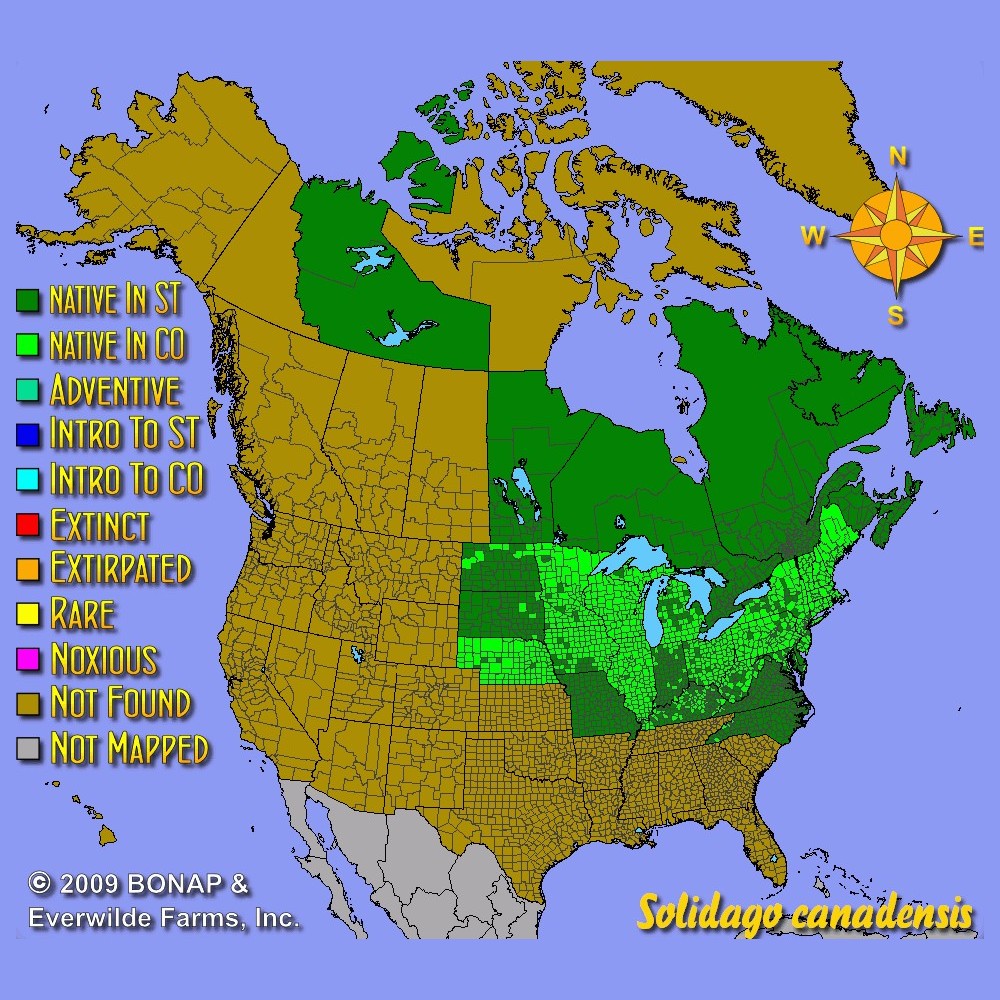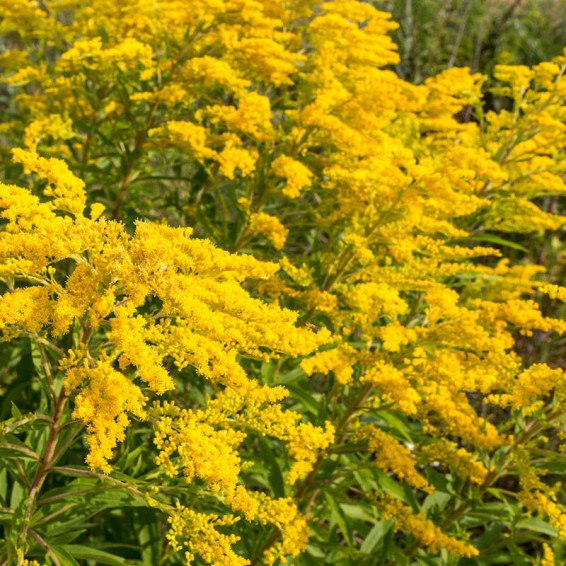Canada Goldenrod Seeds
- HOW TO GROW
- FAST FACTS
- REVIEWS
HOW TO GROW
Sowing: Direct sow in late fall, pressing into the surface of the soil since this plant needs light to germinate. For spring planting, mix the Canada Goldenrod seeds with moist sand and store in the refrigerator for 60 days before planting. Keep the soil lightly moist until germination.
Growing: Water seedlings occasionally until they become established. Mature plants prefer slightly moist soil, though they do tolerate some drought in addition to growing well in clay or sandy soils. This plant attracts bees and butterflies. It will self-seed, and can spread rapidly by rhizomes.
Harvesting: For cut flowers, choose stems with flowers that have just opened. Strip the foliage that will fall below the water level, and place in water immediately.
Seed Saving: As the blooming fades, the plumes will turn from yellow to white as they develop the seed. The Solidago Canadensis seed can easily fly away on the wind because of its white fluff, and should be gathered as soon as possible. Strip the seed from the stems, and remove as much plant material as possible. Store the Canada Goldenrod seeds in a cool, dry place.
FAST FACTS
Latin Name: Solidago canadensis
Species Origin: US Native Wildflower
Type: Native Wildflowers
Life Cycle: Perennial
USDA Zones: 2, 3, 4, 5, 6
US Regions: Plains/Texas, Midwest, Northern, Northeast
Seeds per Ounce: 140,000
Stratification: No Stratification
Germination Ease: No Stratification
Sunlight: Full Sun, Part Sun
Height: 48 Inches
Color: Yellow
Bloom Season: Blooms Early Fall, Blooms Late Fall
Uses: Attracts Pollinators, Attracts Honeybees, Attracts Butterflies, Deer Resistant
Always Reliable Product and Service
Can always count on quality seeds from Everwilde and exceptionally fast shipping. We won't be setting these up for late summer early fall flowering 2023 for several months yet, but have no doubt we will get quite the event once we get there. 3/4 ounce of goldenrod will make quite the event. Can't show pictures obviously.
First time customer and very pleased
This was the first time(it won't be the last} that I ordered from Everwilde. I was searching on the internet for a supplier of goldenrod seeds which were reasonably priced and was fortunate to find this company. The price of the seeds including shipping was fair. I received my order in a timely fashion. The seed package besides being very attractive is also made of foil which keeps the seeds viable for a longer period of time. the company also offers a huge variety of seeds, some of which have been hard to find. Very pleased with this transaction
Great service and seeds.
Orders are quickly filled. Past seeds I've purchased have germinated, grown well and are true to name.
ALWAYS great service and products
We have always been impressed with quality of service for all seed products from Everwilde with exceptional germination rates when basic planting instructions are followed. This is the second time we have ordered Canadian goldenrod from them. This purchase which will be set up for 2022 growing season was due to our extreme [for us in the PNW] dry and hot weather and about 60% of our goldenrod cooked out before flowering. They may or may not come back, but we have re-strategized one NEW location to plant them that provides slightly less sunrise to sunset exposure and the ability to water if needed.
DESCRIPTION

HOW TO GROW
Sowing: Direct sow in late fall, pressing into the surface of the soil since this plant needs light to germinate. For spring planting, mix the Canada Goldenrod seeds with moist sand and store in the refrigerator for 60 days before planting. Keep the soil lightly moist until germination.
Growing: Water seedlings occasionally until they become established. Mature plants prefer slightly moist soil, though they do tolerate some drought in addition to growing well in clay or sandy soils. This plant attracts bees and butterflies. It will self-seed, and can spread rapidly by rhizomes.
Harvesting: For cut flowers, choose stems with flowers that have just opened. Strip the foliage that will fall below the water level, and place in water immediately.
Seed Saving: As the blooming fades, the plumes will turn from yellow to white as they develop the seed. The Solidago Canadensis seed can easily fly away on the wind because of its white fluff, and should be gathered as soon as possible. Strip the seed from the stems, and remove as much plant material as possible. Store the Canada Goldenrod seeds in a cool, dry place.
FAST FACTS
Latin Name: Solidago canadensis
Species Origin: US Native Wildflower
Type: Native Wildflowers
Life Cycle: Perennial
USDA Zones: 2, 3, 4, 5, 6
US Regions: Plains/Texas, Midwest, Northern, Northeast
Seeds per Ounce: 140,000
Stratification: No Stratification
Germination Ease: No Stratification
Sunlight: Full Sun, Part Sun
Height: 48 Inches
Color: Yellow
Bloom Season: Blooms Early Fall, Blooms Late Fall
Uses: Attracts Pollinators, Attracts Honeybees, Attracts Butterflies, Deer Resistant
Reviews
Review
Always Reliable Product and Service
Can always count on quality seeds from Everwilde and exceptionally fast shipping. We won't be setting these up for late summer early fall flowering 2023 for several months yet, but have no doubt we will get quite the event once we get there. 3/4 ounce of goldenrod will make quite the event. Can't show pictures obviously.
Review
First time customer and very pleased
This was the first time(it won't be the last} that I ordered from Everwilde. I was searching on the internet for a supplier of goldenrod seeds which were reasonably priced and was fortunate to find this company. The price of the seeds including shipping was fair. I received my order in a timely fashion. The seed package besides being very attractive is also made of foil which keeps the seeds viable for a longer period of time. the company also offers a huge variety of seeds, some of which have been hard to find. Very pleased with this transaction
Review
Great service and seeds.
Orders are quickly filled. Past seeds I've purchased have germinated, grown well and are true to name.
Review
ALWAYS great service and products
We have always been impressed with quality of service for all seed products from Everwilde with exceptional germination rates when basic planting instructions are followed. This is the second time we have ordered Canadian goldenrod from them. This purchase which will be set up for 2022 growing season was due to our extreme [for us in the PNW] dry and hot weather and about 60% of our goldenrod cooked out before flowering. They may or may not come back, but we have re-strategized one NEW location to plant them that provides slightly less sunrise to sunset exposure and the ability to water if needed.





